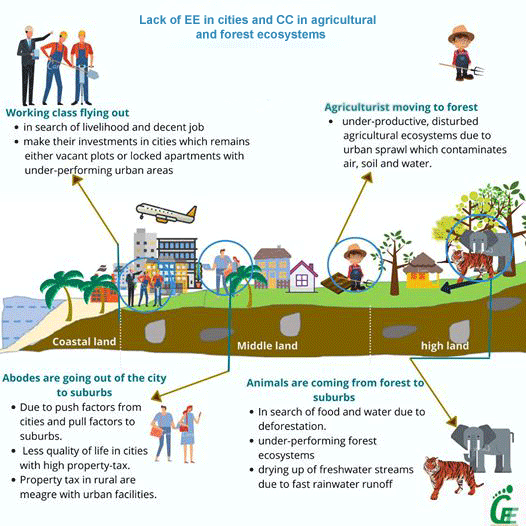Halting Human development
Three components of human development concept of United Nations are health, education and percapita income. The state of Kerala attained laudable achievements in the case of health and education (basic level). Due to less economic development scenario state is striving hard to maintain the health and educational achievements in the business- as- usual scenario. Now the state, has been facing serious crisis due to spreading of diseases like dengue and chicken guinea increasing incidence of road accidents and is a haven of life style diseases. Less investments coming to state results in less job opportunities. People are depending on other productive urban areas outside Kerala and abroad to make their livelihood. Percapita public debt of the state is skyrocketing and is highest among all the south Indian states.
Although Kerala State as a whole is having substantial gross residential density (3rd among the states of India as per 2001 census) state lacks population concentration in cities where the quality of life enhancement can be made with higher order infrastructure. The viability of higher order infrastructure and facilities depends on the number of users in the case of private investment and the amount of tax collected in the case of government. The revenue expenditure of the state government is very high compared to the revenue receipts. State government is borrowing money from external sources and lion’s share of the state income is being expended for debt service charges. Hence the state is unable to provide world class standards which contribute to desired human development. Further it is stated that many of the human development prone facilities provided are under- utilised due to lack of accessibility as major share of time is spend on travelling due to inefficient transport system.
SPIRALING ECOLOGICAL FOOT PRINT (EFp)
The ecological foot print of an average Keralite is very high due to the following reasons.
- The food he consumes is manufactured or cultivated outside Kerala and fossil fuel is burnt to transport the same. More forest land is required to sequestrate the carbon dioxide discharged during burning. (fossil fuel foot print is evaluated based on the assimilative capacity of the environment)
- As the settlement pattern is scattered huge energy is wasted on transportation to reach the human development prone centers, again leading to more fossil fuel consumption, which is either shouldered by individual or by government. ‘Kerala State Road Transport Corporation’ is not profitable in Kerala and the reason may be the un-viable number of passengers, as population concentration phenomenon is very meagre.
- Due to scattered settlement pattern ‘built up area / land’ foot print is very high as scattering of built up area reduce the productivity of the intermittent land (which remains under performing or non-performing). The high electrical distribution losses prevail in Kerala as distribution lines are covered in non-performing areas also.
- The economic base of Kerala is the remittances of Non-Resident Keralites (NRKs). The energy foot print of a non-resident Keralite is high as he often depends on air travel to reach the home land burning huge amount of fossil fuel.
- High labour charges prevalent in Kerala also may be due to high per capita ecological footprint and they are spending lion’s share of their income for transportation. From all the above the EFp of a Keralite is very high which can be a comparable figure to the EFp of developed countries while enjoying less comfort than the people in developed countries.
Diminishing Biocapacity
As per the procedure adopted by the WWF, in the Living Planet Report, biocapacity of Kerala can also be derived which will be a diminishing figure as the productivity of agriculture, forest, marine and wet land ecosystems are less compared to the world average productivity. Integrity of ecosystems is lost due to the disturbance to the ecosystem due to human activities.
Diminishing EE and CC
The efficiency indicator EE in the urban context and CC in the regional context, both are having a diminishing trend in the case of State of Kerala. From all the above it is clear that any sincere effort to improve the crisis of Kerala model is to concentrate on the efficiency indicators EE and CC. Formulating policies, programs and legal tools to improve the EE and CC values are the need of the hour. Also it is true that there is no magic wand to improve the Kerala situation other than long term measures. Through reforms in urban planning and applying energy efficient technology EE of Kerala can be improved in a phased manner. Encouraging planned, compact, high density development with compatible mixed land use around human development prone centers alongwith the energy conservation technologies can go a long way to improve EE of Kerala. This in turn improves the CC also as biocapacity improves when the ecosystem is undisturbed. CC can further be improved through regional planning measures and inculcating functional dependencies in the region which in turn can reduce the fossil fuel consumption for transportation of resources to the human development centers.
EE&CC of Kerala

















